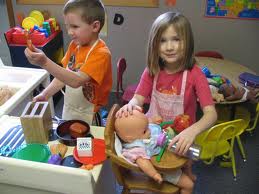Scaffolding/Providing Support to Your Child
According to developmental psychologist Lev Vygotsky, a child should be helped within the zone of proximal development. This means you support a child doing a task that is “challenging for the child, slightly above his or her independent level of functioning, but not frustrating” (Hirsch, 2009). Within this zone, you provide support to the child on a continuum from lots of support to very little support.
The guidelines of degrees of support are: fewer choices to more choices, different choices to similar choices (comparing a circle to a square vs circle to an oval), concrete to abstract, demonstration to language only, receptive response (the child just points) to expressive response (asking a child an open ended question), many verbal cues to fewer verbal cues, step by step support to summarizing, The following are applications of this:
Setting Table
High Support
He watches you set the whole table, or he does only a tiny part of the task.
Have a placemat with a drawn outline of the forks, plate, etc. for him to place the object directly on top of.
Medium Support
Have one spot already set for the child to look to as an example.
Or ask him step by step “How many people in our family? So how many forks do we need?”
Low Support
Have the child do the whole task providing language support, not concrete modeling.
Oral Language Development:
High Support
Asking yes and no questions or questions that allow the child to point as an answer. “Which tower is taller?”
Low Support
Tell me about your tower.
High Support
“I want you to sit between Bill and Sue. That means sitting right here. Point to spot. Bill is right here (pointing) on one side of you and Sue (pointing) is here on the other side of you.”
Low Support
Please sit between Bill and Sue
High Support
“Mary’s Mom brought cookies for snack. Can you say ‘Thank you, Mrs. Smith’?”
Low Support
“Mary’s Mom brought cookies for snack. What can you say to Mrs. Smith?”
Emotional Intelligence/Conflict Resolution
High/Medium Support
Model positive interactions with others in front of the child, such as modeling empathy or finding multiple solutions to a problem.
Say your thoughts out loud so the child can learn how you are thinking through solving the conflict.
Have your child look at himself in the mirror when experiencing a particular emotion so he can connect the facial expression and word of the emotion with the actual feeling.
Explain the emotions of others: “The reason he is so angry is that he is not ready to leave the swimming pool. Have you ever felt that way when you had to stop doing something you were enjoying doing?”
Ask your child to repeat after you what to say word-for- word.
If your child is trying to take a toy from another, have him repeat, “When you are done with that toy, can I play with it?”
Or offer solutions to the child. “Someone else is playing with the digger truck. Maybe you can play with the dump truck while you wait.”
If someone else takes his toy, he can repeat, “I feel frustrated when you take my toy. Stop doing that.”
Low Support
Ask questions: “What can you say or do instead of taking the other child’s toy? What can you say or do while you wait?”
Usually, children need high and medium support with this for years. Rarely, does the phrase use your words help because the child doesn’t know what words to use.
REFERENCE
Hirsch, E.D. (2009). Core knowledge preschool sequence. Charlottesville, VA: Core Knowledge Foundation.



